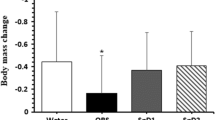Abstract
The effect of commercial oral rehydration solutions (“sports drinks”) relative to water on risk of nephrolithiasis has not been studied previously. We studied the effect of two sports drinks, Performance (Shaklee Corp., Pleasanton, CA, USA) and Gatorade (Gatorade, Chicago, IL, USA) on urinary chemistry and measures of lithogenicity in non-stone formers. Performance has a pH of 4.3, and contains 21 mmol/L of sodium, 5.3 mmol/L of potassium, 0.8 mmol/L of calcium, and 19.5 mmol/L of citrate. Gatorade pH ranges from 2.9 to 3.2, and contains 20 mmol/L of sodium, 3.2 mmol/L of potassium, negligible calcium, and 13.9 mmol/L of citrate. Subjects drank 946 ml (32 oz) of tap water daily for 3 days, and recorded diet history. This was followed by a second 3-day experimental period during which subjects drank 946 ml (32 oz) of sports drink daily, duplicating diets from part 1. In each 3-day period, urine was collected for 24 h during days 2 and 3. Urine chemical analysis was performed, and supersaturations of calcium oxalate, calcium phosphate and uric acid were calculated. Nine subjects completed the study using Performance, ten used Gatorade. Urine volumes and creatinine excretions were not different during the control and experimental periods. Performance increased mean citrate excretion by 170 mg/day (95% CI 57–284 mg/day; P = 0.01) and increased urine pH by 0.31 (95% CI 0.03–0.59; P = 0.03). Gatorade did not significantly change urinary citrate excretion or pH. Neither drink caused significant differences in the excretion of sodium and calcium or any supersaturation value. Ingestion of Performance, but not Gatorade, led to an increase in mean urinary citrate excretion and pH as compared to water. The increase in citrate is likely to be a clinically significant effect. pH is an important determinant of alkali load in beverages containing organic anions. Performance, with more citrate and a higher pH than Gatorade, could represent a superior alternative to water for reducing urinary lithogenicity. Most sports drinks with significant carbohydrate content however may contain too many calories, and fructose, to be preferred beverages for stone prevention.

Similar content being viewed by others
References
Siener R, Hesse A (2003) Fluid intake and epidemiology of urolithiasis. Eur J Clin Nutr 57(suppl 2):S47–S51
Borghi L, Meschi T, Schianchi T et al (1999) Urine volume: stone risk factor and preventive measure. Nephron 81(suppl 1):31–37. doi:10.1159/000046296
Borghi L, Meschi T, Amato F et al (1996) Urinary volume, water and recurrences in idiopathic calcium nephrolithiasis: a 5-year randomized prospective study. J Urol 155:839–843. doi:10.1016/S0022-5347(01)66321-3
Goldfarb DS, Coe FL (1999) Prevention of recurrent nephrolithiasis. Am Fam Physician 60:2269–2276
Parks JH, Goldfischer ER, Coe FL (2003) Changes in urine volume accomplished by physicians treating nephrolithiasis. J Urol 169:863–866. doi:10.1097/01.ju.0000044922.22478.32
Warner M (2006) Soda sales fall for first time in 20 years. New York Times
Curhan GC, Willett WC, Rimm EB et al (1996) Prospective study of beverage use and the risk of kidney stones. Am J Epidemiol 143:240–247
Asplin J, Parks J, Lingeman J et al (1998) Supersaturation and stone composition in a network of dispersed treatment sites. J Urol 159:1821–1825. doi:10.1016/S0022-5347(01)63164-1
Finlayson B (1977) Calcium stones: some physical and clinical aspects. In: David DS (ed) Calcium metabolism in renal failure and nephrolithiasis. Wiley, New York, pp 337–382
Lemann J Jr, Piering WF, Lennon EJ (1969) Possible role of carbohydrate-induced calciuria in calcium oxalate kidney-stone formation. N Engl J Med 280:232–237
Taylor EN, Curhan GC (2008) Fructose consumption and the risk of kidney stones. Kidney Int 73:207–212. doi:10.1038/sj.ki.5002588
Nakagawa T, Hu H, Zharikov S et al (2006) A causal role for uric acid in fructose-induced metabolic syndrome. Am J Physiol Renal Physiol 290:F625–F631. doi:10.1152/ajprenal.00140.2005
Asselman M, Verkoelen CF (2008) Fructose intake as a risk factor for kidney stone disease. Kidney Int 73:139–140. doi:10.1038/sj.ki.5002700
Odvina CV (2006) Comparative value of orange juice versus lemonade in reducing stone-forming risk. Clin J Am Soc Nephrol 1:1269–1274. doi:10.2215/CJN.00800306
Seltzer MA, Low RK, McDonald M et al (1996) Dietary manipulation with lemonade to treat hypocitraturic calcium nephrolithiasis. J Urol 156:907–909. doi:10.1016/S0022-5347(01)65659-3
Kang DE, Sur RL, Haleblian GE et al (2007) Long-term lemonade based dietary manipulation in patients with hypocitraturic nephrolithiasis. J Urol 177:1358–1362. doi:10.1016/j.juro.2006.11.058
Penniston KL, Steele TH, Nakada SY (2007) Lemonade therapy increases urinary citrate and urine volumes in patients with recurrent calcium oxalate stone formation. Urology 70:856–860. doi:10.1016/j.urology.2007.06.1115
Asplin JR (1996) Uric acid stones. Semin Nephrol 16:412–424
Phillips MJ, Cooke JN (1967) Relation between urinary calcium and sodium in patients with idiopathic hypercalciuria. Lancet 1:1354–1357. doi:10.1016/S0140-6736(67)91763-1
Abate N, Chandalia M, Cabo-Chan AV Jr et al (2004) The metabolic syndrome and uric acid nephrolithiasis: novel features of renal manifestation of insulin resistance. Kidney Int 65:386–392. doi:10.1111/j.1523-1755.2004.00386.x
Taylor EN, Stampfer MJ, Curhan GC (2005) Obesity, weight gain, and the risk of kidney stones. JAMA 293:455–462. doi:10.1001/jama.293.4.455
Taylor EN, Stampfer MJ, Curhan GC (2005) Diabetes mellitus and the risk of nephrolithiasis. Kidney Int 68:1230–1235. doi:10.1111/j.1523-1755.2005.00516.x
Cameron MA, Maalouf NM, Adams-Huet B et al (2006) Urine composition in type 2 diabetes: predisposition to uric acid nephrolithiasis. J Am Soc Nephrol 17:1422–1428. doi:10.1681/ASN.2005121246
Acknowledgments
This work was supported in part by NIH grant 2R44DK59086-02 and by the Dept. of Veterans Affairs. We appreciate the administrative support of Frank Modersitzki.
Author information
Authors and Affiliations
Corresponding author
Rights and permissions
About this article
Cite this article
Goodman, J.W., Asplin, J.R. & Goldfarb, D.S. Effect of two sports drinks on urinary lithogenicity. Urol Res 37, 41–46 (2009). https://doi.org/10.1007/s00240-008-0166-0
Received:
Accepted:
Published:
Issue Date:
DOI: https://doi.org/10.1007/s00240-008-0166-0




